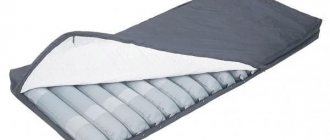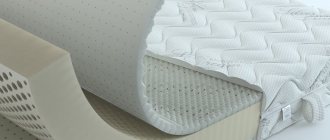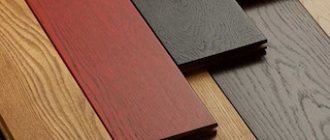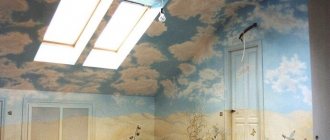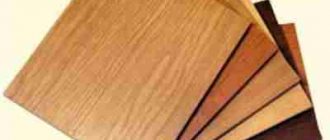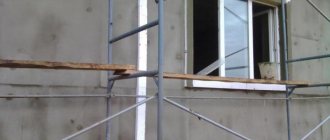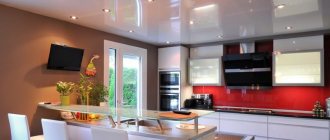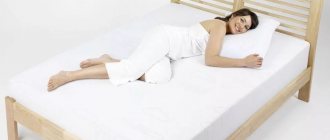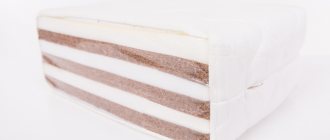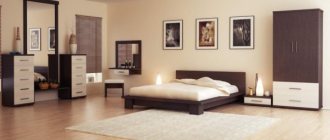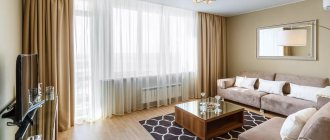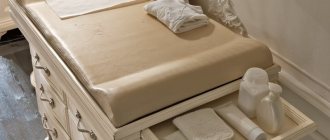Foam mattresses are in demand due to their price and large selection of models. The orthopedic characteristics of the product are quite high. Now the item uses not the same foam rubber that was previously used in furniture, but an improved one. Its name is polyurethane foam. The material belongs to the category of gas-filled plastics, which, after foaming, form an elastic, homogeneous mass that will ideally bend to the anatomical curves of the body. Thanks to this property of polyurethane foam, models can be made from it that provide good support for the spine.
Spring block
This option is used
for
many years
and to this day.
Its main advantage
is a high level of comfort, correct and uniform distribution of a person’s weight both in a sitting and lying position.
There are two types
of spring fillers:
dependent,
called
“Bonnel”
and
independent
, called
“Pocket spring”.
To the main advantages
spring blocks include:
- Long service life
with proper quality of workmanship; - Reliability;
- Ability to withstand
significant
loads; - The surface
of the sofa will be
smooth,
without dents; - Elasticity
and sufficient rigidity, which can be selected depending on the number of springs and their density; - Possibility of free air circulation,
which will prevent the appearance of various insects; - Orthopedic properties
that your spine will appreciate.
Flaws,
Of course, there are also:
- Over time, squeaking may occur;
- Independent blocks have a high cost;
- If one or more springs break, repairs
can
be
quite
expensive;
Polyurethane foam
PPU
is
a synthetic,
highly porous foam
material
that is obtained by mixing several synthetic polymers.
In its density it can exceed materials such as rubber and caoutchouc. This indicator affects the quality of polyurethane foam products. For furniture, polyurethane foam is usually used with an indicator of 30 to 40 kg per square meter. The higher this indicator, the more durable
the product will be.
Material with an index of less than 30 units is used only for the manufacture of decorative pillows. To find out what filler density your chosen model has, you need to ask for a passport
for the product.
For factory furniture this parameter will definitely be indicated. The technology for producing
this material is quite simple, which has a positive effect on its cost.
There are two types
PPU:
For the manufacture of various elements of the sofa, sheets of different degrees of rigidity are used. Products made from polyurethane foam are not tolerated
exposure to direct
sunlight.
Under their influence, they can crumble, so mattresses made of this material are additionally
protected with covers
made of light-proof fabric.
An interesting feature of some PU foam compositions is that they have a shape memory effect.
Usually from it, they remember the contours of the human body and adapt to them as much as possible. But as soon as you get up, the pillow will instantly return to its original state.
A product filled with high-quality polyurethane foam will be more affordable in price than
“Pocket spring”
block but in terms of its properties and level of comfort approximately the same.
This mattress can also be used for sleeping.
"Bonnel" will be cheaper than both of these options and significantly worse in technical characteristics.
To the benefits
PPU can be classified as:
- Long
service life; - Absolute safety
and environmental friendliness of the material; - Good balance of softness/hardness;
- Air
and
moisture permeability; - The material does not provoke allergic reactions;
- Does not accumulate dust;
- Rapid restoration of shape
after deformation due to high elasticity; - Ability to withstand significant loads
for long periods of time.
Disadvantages
this material has significantly
less:
- Cheap polyurethane foam
quickly loses its elastic properties, which is why dents will soon appear in places of greatest load: - Some types of polyurethane foam may seem quite rigid
compared to a spring block.
Sintepon
Very common
material that is used as filler in
inexpensive models.
It is a synthetic material in the form of a non-woven fabric.
It is made from polyester fibers. The best option
would be to use it in combination with other types of filler.
Usually it serves as an intermediate layer
between full filler material, such as polyurethane foam, and upholstery.
It gives the finished product additional softness and elasticity. The advantages
of padding polyester include:
- Low cost;
- is environmentally friendly
, due to which it is not prone to the appearance of fibers inside; - Despite its synthetic origin, synthetic winterizer does not cause allergies
and can be used as a filler even for; - Its structure
is elastic and
resilient.
Despite all the positive qualities, it has a number of significant disadvantages:
- The most important one is the short operating period.
With active use and frequent loads, this material loses its elastic properties, and dents and irregularities quickly form on the surface of the product. Therefore, despite the affordable cost, furniture filled with padding polyester will last a very short period. - At the moment there is no unified production technology for this material. Therefore, you risk purchasing a low-quality product,
in the manufacture of which harmful substances could be used. To avoid this, be sure to ask the seller for a certificate for the product, which can confirm its safety. - As a full-fledged filler, it can be used only for pillows or armrests, in some cases for the backrest, in order to give it decorative bends or protrusions. For example, if the back of the sofa is made using the “carriage screed” technology;
- Over time it clumps
into clumps.
Having assessed the advantages and disadvantages, we can come to the conclusion that such material is better suited for a sofa,
which will be used in
the living room.
Is it possible to replace the foam in the cartridge?
Quite often, the original foam rubber in the cartridge becomes unusable and people wonder what can replace it. The fact is that the foam rubber in such a product cannot be replaced with anything else. It ensures ink retention, allowing only the right amount to print. You only need to use the same material or purchase a new cartridge.
Foam rubber is a common material that is used not only as a filler for furniture. In some cases, it is possible to find an alternative to this material, but in others it is better to leave it alone. Analogs have both advantages and disadvantages, which is important to consider before purchasing.
Periotec
This is modern
non-woven
material,
which consists of high quality polyester fibers.
It is increasingly used for the manufacture of mattresses and various bedding, as well as for filling. Thanks to special additives
in the form of artificial components (for example, corn fibers, bamboo or viscose), or natural fibers (wool, coconut, linen or cotton), this material
has
high
strength
and elasticity.
Along with these indicators, the service life of products with such filler also increases. To strengthen
the perioteca, knitted fabric can be additionally used - dublerin, non-woven single-stitched or needle-punched fabric or woven fabric, such as calico.
To understand exactly what components are included in the composition and what level of hardness this filler can provide, it has a special marking.
It also indicates the density and width.
To obtain this material, which is still unusual for us, a special technology is used.
It consists of the formation
of three
different
layers.
The first layer is the main one, it must bear the entire load.
Its fibers are laid in a vertical direction and fixed in this position under the influence of high temperature. The second
and
third
layers serve as reinforcement.
They strengthen and support the first layer. This unique structure
explains the high technological performance of this type of filler.
Advantages
perioteca are obvious:
- The material is hypoallergenic;
- In its structure,
of harmful and pathogenic
microorganisms is impossible - It is completely safe
for human health. This is explained by the fact that its composition does not contain glue, resins and other components that can be toxic. The fibers are bonded under the influence of temperature. - Periotec mattresses provide a very high level of comfort;
- Able to restore shape with a small indicator of residual deformation
even under prolonged exposure to significant loads;
Its elasticity
indicator are similar to
those of an independent
spring unit;- Durability,
thanks to a three-layer reinforced structure; - Air permeability;
- Fire safety.
To the disadvantages
can be attributed:
- The cost
is equal to the cost of the “Pocket spring” block. - This material is ideal for filling upholstered furniture, but may be too hard for some.
In such cases, it is used as the main, elastic layer, and to achieve a lower degree of rigidity, softer materials are additionally used.
This sofa can be used for
daily
sleep.
After all, the degree of its deformation is practically reduced to a minimum.
Mattresses made of polyurethane foam (PPU), including vacuum mattresses in rolls
In the production of polyurethane foam mattresses, elastic polyurethane foam (furniture PU foam) is used. Polyurethane foam (PPU) is an artificial cellular filler (visually comparable to a sponge) and is a proven and safe material, which confirms its widespread use in everyday life. The main distinguishing feature of PU foam mattresses is their light weight, so such mattresses are well suited, for example, for beds that are folded into a closet in a vertical position.
You can read more about polyurethane foam in the article “Polyurethane foam | Description of materials used in mattresses."
Springless polyurethane foam mattresses are produced in two types:
- Mattresses made from a monolithic (single) block of polyurethane foam with an average height of about 16 cm.
- From thin layers of polyurethane foam (for example, a mattress 16 cm high will consist of 5 layers of 3 cm each) - this is a cheaper method, polyurethane foam is usually used of lower quality, the layers are connected using glue.
In terms of hardness, such mattresses are usually produced closer to hard (above medium hardness) or medium hardness, and less often closer to soft (below medium hardness). Mattresses above medium hardness are perfect for children, teenagers and young adults; taking into account the light weight of the sleeper, you can choose a mattress of good hardness at a low price.
The main characteristics of polyurethane foam are density and rigidity. Density is a value that reflects the ratio of mass and volume (kg/m3). The ratio of density and hardness determines the quality of PU foam in mattresses. In this case, the main indicator is density, the higher the density, the better. And the rigidity may not be high (for example: in cheap brands of polyurethane foam the density indicator is low, but the rigidity indicator is high).
Manufacturers of mattresses almost never indicate the physical values of density and hardness, but at the same time, conscientious manufacturers indicate real figures for such important indicators as: maximum load per 1 bed and the service life of the mattress. Based on these indicators, polyurethane foam in springless mattresses can be divided into 3 classes:
- Cheap - mattresses with such a filling are often no higher than average in terms of hardness, and are among the cheapest, with an average service life of 3 years, and a maximum load per bed of up to 90 kg.
- Normal - mattresses with such a filling are often of medium or above medium hardness (closer to hard), relatively inexpensive, service life on average 5-7 years, maximum load - up to 110 kg.
- Good - mattresses with such a filling are often of medium or above medium hardness; such mattresses are expensive and can often be more expensive than spring mattresses with an independent PF "TFK" or even "Multipackage". The service life is on average 10 years, the maximum load can reach up to 140 kg.
Cheap polyurethane foam mattresses are also called PU foam or foam mattresses.
Note: Foam rubber is the trade name for elastic polyurethane foam, which in the Soviet Union was mainly produced by the Scandinavian company Porolon. Therefore, many have the opinion that mattresses made of polyurethane foam are always of low quality, but this is not so. Polyurethane foam is generally widely used in everyday life, for example: in car seats, in sofas, in sponges for washing dishes, in construction foam blocks. PPU material has wide application and varied quality.
The rest of the mattresses are made from PU foam, usually called mattresses made from artificial latex (highly elastic PU foam).
Some mattress manufacturers additionally indicate the brand of polyurethane foam used - this is useful information that can be used to assess the quality of the filler. For example, a foreign brand may be indicated in the description of the filler (for example: Vegaflex artificial latex manufactured by Vita, England) - this is an indicator that most likely the PU foam is of minimum quality not lower than average, because usually the PU foam of foreign brands used in mattresses is of good quality, and at the same time, knowing the manufacturer of polyurethane foam, you can find out some additional information about the filler. Also, some Russian manufacturers, extremely rarely, indicate the brand of Russian polyurethane foam, knowing this data you can find out the characteristics of the polyurethane foam used (the brands of Russian polyurethane foam can be found, for example, on the website of the SIBPLAST plant).
You can evaluate the quality of the filler by touch when comparing two mattresses of the same hardness. The higher the quality of polyurethane foam, the higher the density and elasticity, i.e. if you press on the mattress, for example, from above with your hand clenched into a fist, the mattress will push your hand back. A mattress that has a higher buoyant effect (elasticity) is better, because the filler will recover faster after load and will last longer.
The photograph shows samples of two mattresses of the same hardness (above average), the one on the left has a mattress with lower elasticity and density than the mattress on the right.
What does vacuum mattresses on a roll mean?
The photographs show a single vacuum mattress measuring approximately 80x200 cm.
Vacuum mattresses on a roll are mattresses that are compressed in height under a special press at the factory, hermetically packaged in a special plastic vacuum packaging and rolled into a compact roll (along the length of the mattress). For example, a springless polyurethane foam mattress measuring 160x200 cm and a height of 20 cm, in vacuum packaging will be 160 cm long and a roll diameter of about 40 cm, weighing about 18 kg (for example, a regular spring mattress weighs on average about 40-50 kg). Such mattresses are very convenient for independent transportation (for example, it’s easy to take a mattress to the country in your own car).
Most PU foam mattresses are vacuum packed.
You can additionally read about comparisons and descriptions of specific mattress models in the article “Vacuum mattresses in rolls for home and garden.”
A visual video about the factory packaging of a vacuum mattress in a roll and an example of unpacking the mattress
Struttofiber
One of the most resilient
types of modern fillers, which is ideal for filling upholstered furniture.
Its second name, “non-woven independent springs,”
speaks for itself.
It is made from synthetic and natural fibers such as cotton, linen, coconut, camel hair or combinations thereof. The manufacturing technology
is reminiscent of the process for obtaining Periotec.
The carrier layer fibers are also laid vertically and fixed using a stream of very hot air. This technology is called “strutto”. Thanks to this, the finished material has increased elasticity and wear resistance. It is
able to accurately
adapt to the contours
of the body and prevent problems with the musculoskeletal system.
Struttofiber has a number of significant advantages:
- It is not subject to rotting;
Its
service life
is very long;- Due to increased elasticity, it restores shape
after prolonged loads; - Withstands
heavy
weights; - Does not absorb moisture;
- Does not support
process
; - Breathable;
Dust
mites
and other microorganisms cannot appear in this material- Hypoallergenic;
- Does not produce
unnecessary noise or
squeaks; - Has a reasonable price.
It is necessary to select the correct stiffness for different weight categories, for example:
- Filler with a high hardness index
is recommended for people weighing 90 kg or more; - The average level
of rigidity can withstand loads weighing from 60 kg to 90 kg; - Soft
filler is recommended for use by people whose weight does not exceed 60 kg.
Due to such weight restrictions, difficulties
when choosing among older people who are uncomfortable sleeping or sitting on a hard surface, but whose weight exceeds the permissible norms.
Cons of cotton mattresses
Despite the above advantages, such products also have many disadvantages, which can be critical in one case or another:
- No anatomical properties . The filler is not able to adapt to the structure of the body. Because of this, the quality of sleep and rest deteriorates, since the muscles cannot assume a completely relaxed position.
- The spine does not receive orthopedic support . This is fraught with deterioration in well-being, leading to headaches and muscle pain, fatigue, and irritability.
- The mattress can still lead to the development of allergies . The reason for this is the naturalness of the filler, which is a favorable environment for the development of dust mites. The material itself is considered safe, but due to the activity of mites and other organisms, allergies and other diseases may occur.
- Requirement for care . If not properly cleaned and dried, the mattress can quickly become unusable.
- Relatively short service life . Regardless of the quality of the cotton wool, it will gradually cake and form lumps. Because of this, the sleeping surface loses its even shape and becomes even less suitable for quality rest.
- Insufficient breathability . Due to the large layer of filler, moisture entering its structure does not have time to completely evaporate. As a result, the mattress acquires an unpleasant odor, which can often only be dealt with by “roasting” it in an autoclave.
Most manufacturers claim a service life of their cotton wool mattresses of 5 years . However, in reality the situation is usually much worse . With active use, such products last on average 1 year . During approximately this period, bumps and pits appear, making the mattress uncomfortable to use. After about 2 years, subject to daily use, the mattress can be considered no longer suitable for use.
Felt and padded jacket
Felt is a non-woven material of natural origin,
which is obtained from felted goat or sheep wool.
The structure of these types of wool makes it possible to obtain a very dense material, the formation of which uses high-temperature pressing. It is rolled through hot cylinders, after which a fairly strong and hard crust is obtained on both sides of the sheet. Felt is produced in the form of panels that have different thicknesses. The quilted jacket
is
a composition
of cotton wool, the layer of which is 5 cm thick and dense fabric that covers it on both sides. It can be investment, bag, gauze fabric or technical calico. To connect all layers to each other, use machine stitching with dense threads at a certain interval.
These two materials are not
usually used
as
100%
filler due to their excessive density
. However, felt serves as a protective layer
for spring or polyurethane foam blocks, making their surface more wear-resistant and protecting them from crushing.
This significantly increases the service life of the products. The quilted pad is used as an intermediate layer
between fillers.
It is used to increase the comfort and convenience of a sleeping place. These materials have many advantages:
- Protective properties
that increase the service life of upholstered furniture; - Natural components
in the composition that allow this filler to be used even for small children's sofas; - High
density and
wear resistance; - Affordable price;
- Hypoallergenic;
- Possibility of
uniform
load distribution; - well .
- Smooth surface
even after many years of use.
To significant disadvantages
relate:
- Natural wool can harbor insects
and other pests; - This covering absorbs moisture
and can quickly
become moldy,
which is why it needs to be constantly dried, which is extremely problematic to do when it comes to filling for a sofa.
Holofiber
We can say that this is an improved padding polyester.
It resembles small fluffy balls, which are formed from polyester spiral polyester fibers and have many internal pores.
Thanks to its spiral structure
, it has a main advantage that is very much appreciated when choosing filler for upholstered furniture - it is able to quickly restore its shape after prolonged loads.
At the same time, it remains very soft
and warm.
It is actively used as a filler for sofa cushions and seats. furniture material
is used to fill the seats It looks like a mat with the same spiral structure.
It is very thick, elastic, and retains its shape well. Today it is considered one of the highest quality fillers.
This is explained by a large list of its
positive
qualities:
- Absolute safety
and environmental friendliness, which makes it possible to use it to fill children's furniture; - Does not cause allergic
reactions; - Has low weight;
- Does not absorb odors;
- Does not
absorb or collect
dust on its surface; - Easily
changes and
restores shape;
Harmful
microorganisms cannot
form in it ;- Has
high
softness
and elasticity; - Does not absorb moisture;
- Breathable;
- Does not roll down;
- Does not support combustion;
- Has a long
service life.
Significant disadvantages
This material
was not detected.
Perhaps the cost is higher than that of padding polyester.
Springless models
"AlViTek" (Moscow, Russia) - a combination of efficiency and comfort
A Russian manufacturer with more than 20 years of experience in creating cotton mattresses produces products that meet GOST standards in quality, weight and aesthetics and modern ideas about reliable and stylish bedding. Regardless of the size, the accessory consists of a case and a filling of 100% natural composition. What could be better than a material that retains the best natural properties to promote healthy sleep.
Advantages:
- springless model;
- wide size range ranging from 55x145 to 160x200 cm;
- medium degree of hardness;
- The teak mattress cover is durable;
- 100 percent cotton filling weighing from 3 to 11.5 kg;
- good breathability;
- cost from 1000 rub.
Flaws:
- no memory effect;
- There are no carrying handles.
Recommendations: 6 best Ormatek mattresses
Mattress “Comfort” from Valetex (Ivanovo, Russia) from its own fillers
Another Russian supplier of cotton mattresses, for almost 20 years of its activity, has received recognition from many connoisseurs of original visually and functional sleep products. This model attracts attention with its bright colors, original design and practicality. The pleasant-to-touch surface remains the same even after several years of use. Thanks to the correct placement of the filler inside, it does not roll into lumps, and the seams of the cover do not crack.
READ ALSO
How to choose a mattress - expert reviews
Advantages:
- the model does not have springs;
- the spine is effectively supported;
- the product is safe even for allergy sufferers;
- filler made of combed cotton wadding with a multilayer structure;
- uniform placement of filler, secured with peaks;
- mattress thickness 7 cm;
- teak cover with increased wear resistance;
- large selection of colors;
- cost from 1500 rub.
Flaws:
- increased weight.
Cotton model from the Ruson factory (Izhevsk, Russia) for country holidays
Many self-respecting mattress manufacturers include cotton wool models in their range. They are not only affordable, but also famous for their fluffiness and elasticity. A well-known Russian factory offers a model that can be seen at a dacha, in a children's camp or holiday home. Despite the use of not the most wear-resistant material as a filler, such bedding will last for many years, as it is characterized by high quality tailoring, uniform placement of the filler, and a durable cover.
Advantages:
- lack of springs;
- standard rectangular shape, excellent compatibility with bed base;
- environmentally friendly filler made from regenerated fiber;
- cover made of high-quality printed calico;
- uniformity of product thickness and shape;
- use of piping technology when sewing a cover;
- retains heat well;
- cost from 500 rub.
Flaws:
- the cover is not removable.
READ ALSO
6 best Askona mattresses
"Artemis" (Krasnoyarsk, Russia) - an ideal solution for children
The manufacturer's cotton mattresses are in demand due to their softness and fairly light weight. This does not create a hammock effect when under load, and the child can have quality rest. The hygroscopic cover does not cause a feeling of heat or sweating after a night spent on such a bed. Despite the filler made of regenerated cotton wool, the performance characteristics are maintained throughout the stated warranty period. The advantages include the absence of stretching of the product around the perimeter during use.
Advantages:
- excellent prevention of the development of scoliosis in children;
- filler made from regenerated fiber that provides fluffiness;
- breathability;
- neat outer pick;
- smooth, strong seams, no protruding threads;
- pleasant to the touch teak cover;
- sold in vacuum polyethylene packaging in a rolled state;
- 5 year warranty;
- average cost 600 rub.
Flaws:
- striped color.
Omsk nonwoven materials factory: experience and quality
The line of cotton mattresses, produced by a company with more than 80 years of history, is able to satisfy all wishes in terms of product appearance, weight and functionality. Natural filler, cleared of dust, solid particles and combed, is blown into the prepared cover using special equipment, where a favorable microclimate is created. At the same time, the elasticity of the product allows you to stay in comfort both during short-term and long-term rest.
READ ALSO
6 best DreamLine mattresses
Advantages:
- certified products;
- soft hardness;
- natural cotton wool filler;
- the fiber does not have and does not accumulate foreign odors;
- ruler of standard sizes;
- optimal thickness 7 cm;
- wear-resistant calico cover;
- multi-colored outer material;
- cost from 400 rub.
Flaws:
- non-removable cover.
Single “Wadded” from “Shvetex” (Vidnoye, Moscow region)
The product is perfect as a guest option or for a picnic. It is not only practical, perfectly hides all the unevenness of the surface on which it is laid, but also looks elegant for its economy category. All construction materials do not contain glue or components harmful to health.
Advantages:
- an easy-to-carry model that is easy to roll;
- plumping regenerated filler fiber;
- polycotton cover;
- the pick protects the filler from bursting;
- the label contains care instructions;
- cost from 400 rub.
Flaws:
- cannot be washed.
READ ALSO
8 best anti-decubitus mattresses
Foam rubber
The most affordable
in terms of cost and the lowest
quality
type of filler.
Foam rubber is the same polyurethane foam, but of the lowest quality
and lowest density.
Therefore, it is a mistake to think that these are two different materials. Very often, sellers can deceive buyers
by claiming that this is not so.
In fact, they differ only in their characteristics. By the way, the thickness of the foam rubber does not in any way affect the degree of its rigidity. Even a tall sheet can easily wrinkle and be very porous, while a thin sheet can instantly restore its shape. Foam rubber is rarely used as a filler
for soft sofas.
Perhaps, for their armrests or cowls. It has found its application as a material for .
Its positive aspects
This:
- Low cost;
Health safety- Antistatic
properties; - Hypoallergenic;
- Permits air
and moisture well - No
possibility
of mold formation.
Flaws,
unfortunately, very significant:
- Fragility;
- Low quality foam rubber very quickly loses its elastic properties,
causing dents to form on the surface; - Over time, it dries out
and
crumbles; - Not
intended
for filling furniture
that is subject to intensive use.
As you can see, such a filler will very quickly become unusable, and your sofa will quickly lose its aesthetic appearance.
How to replace foam rubber
Foam rubber can be replaced:
| Analogues of foam rubber | Advantages | Flaws |
| Spring block |
|
|
| Polyurethane foam |
|
|
| Sintepon |
|
|
| Periotec |
|
|
| Struttofiber |
| Different levels of firmness suit people of different weights. |
| Felt and padded jacket |
|
|
Latex
This is a filler of natural origin,
which is used in expensive models of upholstered furniture.
It is made from the sap of rubber plants,
which significantly increases its cost.
When is vulcanized
, it is possible to obtain a structure that has many cells that facilitate air penetration and are responsible for hygroscopicity.
The technology for producing
latex, which is used in the furniture industry, is quite simple.
The latex mixture is poured into a container in which it is constantly mixed and foams after a certain period of time. After this, it is poured into special molds and the vulcanization process occurs at a temperature of 100°C. The resulting workpiece is removed from the mold, cleaned of unnecessary foam residues and dried at a temperature of 120°C. After this, the sheets are tested for rigidity, weighed, packaged and sent to the furniture factory. Due to the fact that rubber in its natural form does not tolerate exposure to
fat or
ultraviolet radiation
and
is destroyed
by this, special
stabilizing additives are used in the production of latex mixtures.
Thus, the maximum proportion of natural rubber in latex foam is
no more than 85%.
This product is considered completely natural.
If we talk about the requirements for filler for
upholstered
furniture,
the permissible latex content is
45-60%.
This indicator is quite
sufficient
to obtain the required level of strength, elasticity and wear resistance.
If you are not limited in finances and prefer to use furniture made from natural materials in your home, we recommend that you pay attention to this type of filler. It has a number of advantages:
- The service life
is about 20 years; - Does not cause
allergic reactions; - Breathable;
Follows the contours
as
accurately ;- Able to dampen vibration;
- Evenly distributes the load,
due to which it has orthopedic properties; - Non-toxic;
- very quickly.
To the disadvantages
can only be attributed to its
high cost,
which is due to the specifics of production and the components used.
There is also artificial latex.
This is the name of highly elastic polyurethane foam.
In order not to be deceived,
you need to know that the natural filler has a grayish tint and seems greasy to the touch. While synthetic has a yellowish tint and is dry to the touch.
General characteristics of polyurethane foam fillers
With different hardness and density, different manufacturing technologies and distribution of layers in the “package,” polyurethane foam mattresses have the following unifying properties, which support demand:
Objective
- Elasticity
- Viscosity
- Ergonomics. The combination of elasticity and softness creates that magical ergonomics that makes you feel every millimeter of the part of the body turned towards the bed, leading to an almost meditative state.
- Non-toxic. If we talk about the dangers of polyurethane foam to health.
- Density. Basic quality indicator. Measured in numbers; the lowest value for good material is 30 kg/m3. To check what the seller has stated, just rest your fist on the surface of the mattress: there should be noticeable resistance.
- Rigorous development, including preliminary research and follow-up consumer surveys.
Subjective
- Non-allergic
- Comfort
- Health safety - no more dangerous than other plastic things that surround us when they do not burn.
- Orthopedic properties
The disadvantages include the fragility - up to five years - of soft and cheap fillers, the place of which is more likely in the countryside.
Durafil
This material has a structure
which is similar in performance
to a spring block.
This is a high-quality non-woven fabric, which is made from hollow polyester fibers by heat treatment and gluing the fibers to the base.
Its fibers
are arranged
vertically
and seem to grow from the base, resembling grass.
This structure allows you to achieve high levels of elasticity combined with softness and fluffiness. This material
is
ideal for
filling
sofas,
giving their backs and seats volume and an attractive appearance.
Such furniture looks very cozy and comfortable, and in fact it is. Its advantages
make this material more popular every day:
- Hypoallergenic
material that does not contain substances that can cause even the slightest allergic reaction; - Does not support
process
.
This is due to the peculiarity of production, during which it is subjected to special heat treatment and loses its flammable properties. It may char, become deformed, or collapse completely, but it will not ignite. - High elasticity,
which was achieved thanks to vertically directed individual fibers.
Such a structure actively resists the load,
and when it disappears, the fibers immediately tend to take their original position. - This material does not accumulate dust;
- Resistant
to moisture and
temperature changes; - Has antimicrobial
properties; - It has a pleasant softness,
which makes it popular in the furniture industry; - Long service life.
Disadvantages
this material
has not yet been identified.
And, based on the list of its positive qualities, we can conclude that a sofa with such filling can be used as a full-fledged
sleeping place.
Types of fillers
Natural and regenerated cotton wool is used to create mattresses.
Natural
Speaking about cotton fibers in cotton wool, it is worth clarifying that:
- long cotton fibers are responsible for the strength, elasticity and ability of the product to keep its shape;
- short ones (lint) provide splendor, volume, and thermal insulation.
In addition, natural wool does not contain synthetic fibers. Therefore, mattresses made from them can be freely autoclaved.
Luxury _ Elite white cotton wool containing 70% long cotton fiber and 30% lint (cotton fluff) type A - mature fibers no less than 0.7 cm long. Contains almost no impurities and unripe seeds (up to 2.6%). It is practically not used in mass production of mattresses.
Prima . Second in the ranking of cotton wool quality. Also not used in mass production of sleep products. Long cotton fiber composition - 50%, short cotton fiber - also 50%.
Sewing . A little heavier than Prima cotton wool, but lighter than mattress wool. Long cotton fibers - 35%, short type B - 65%. The most commonly used in mass production of mattresses. The most suitable option for price/quality ratio.
Mattress type 1 . The best in the budget segment. Widely used both in “pure” form and in combination with more expensive types of cotton wool. Lint composition is 70%, long fibers are only 30%.
Mattress type 2 . Contains even more short fibers - 80%, and only 20% long ones. It is often added to Sewing to reduce the cost.
Mattress type 3 . Cotton linters - 90%, long fiber - 10%. Very, heavy, fluffy, but low-strength cotton wool.
Reference! A good single mattress made from sewing wool made in Uzbekistan will cost at least 1,500 rubles.
Regenerated cotton wool
Regenerated fiber or cotton wool (RF) is a product obtained by de-fibering and recycling scraps (throwouts) from sewing and weaving enterprises. Cotton, wool, and synthetic fabrics are used. Therefore, cotton wool can be white or colored.
Important! Synthetic fibers that are part of some types of RF can sinter during autoclaving.
Cotton RF is a defibre of cotton fabrics. The output is white cotton wool. This type of mattress made from this fiber can be autoclaved.
Wool blend RF contains only natural fibers. Some enterprises include sterilization in the technological process.
Mixed fiber contains both natural and synthetic fibers. Not sterilized.
Synthetic fiber consists only of synthetic fibers.
Reference! RF produced on outdated equipment has lumps and loose pieces of fabric. Modern equipment with a large number of technological transitions allows you to avoid these problems and better remove dust from the product.
Improved
Synthetic fluff.
On sale you can find improved models with the addition of synthetic fluff. The springy air fiber adds elasticity and wear resistance. The number of fastening elements (buttons) that prevent the wool from rolling is greater than in standard models (16 fastening punctures are considered the minimum). The price of such models is from 3000 rubles.
Lamels
Do not forget that if you are looking for a sofa that can also act as a sleeping place, then to achieve orthopedic properties
and extending its service life, it is necessary to choose models that are additionally
equipped with lamellas.
Of course,
this is not a type of filler
, but only additional
support
for it, which is very useful.
The slats are
veneered wood strips that have a slightly curved shape.
This design allows you to compensate for the load and ensure correct body position. When pressed, they bend, allowing the load to be evenly distributed. The material used is birch, poplar or beech. The thickness of the lamellas is 2-10 mm. It is clear that the thicker this element and the more often it is located on the frame, the stronger and more durable it will be. The disadvantage of
the slats is that if they break, they cannot be repaired. However, almost anyone can buy a new one and replace it themselves. Especially considering their low cost and the possibility of purchasing even one piece.
Leader among fillers depending on various evaluation criteria
We've listed quite a few different filler options and you're probably already a little confused. To be clear, let's summarize
and highlight the most suitable types depending on various requirements.
Average indicators for duration of operation
When using a sofa as a sleeping place
For sitting with constant and intense load
combined fillings are often used
which allow you to achieve
optimal
rigidity/comfort and price/quality ratio.
Be sure to ask the seller in more detail about all types of fillers used. Ask for certificates
that will confirm the safety of the materials.
And most importantly
, be sure to sit down or lie down on the chosen sofa. You should be comfortable and comfortable on it. It is in this case that you will be satisfied with the purchase.
Over time, as a result of use, upholstered furniture loses some of its characteristics and becomes not as comfortable as initially. Pits or bumps form on the sofa. It is no longer possible to have a good rest on such a sofa. This can happen due to the use of low-quality filler or due to improper use of upholstered furniture. If you wish, you can restore the furniture yourself; just buy new foam rubber and replace it in the sofa. You need to study furniture foam rubber to understand which one to choose for the sofa.
Types of furniture foam rubber
When choosing upholstered furniture for your home, it is very important to pay attention to its comfort. It would be a good idea to ask which filler the manufacturer chose for the manufacture of a particular model. A wide variety of brands can confuse an inexperienced specialist, let alone an ordinary buyer. The selection criteria are density and thickness.
REFERENCE. To assemble upholstered furniture, it is necessary to use material with a density of 30 kg per cubic meter. m. Such sofas can be used both for sleeping and for relaxing while sitting. During operation, the filler is not pressed through.
IMPORTANT. The duration of use of the furniture will depend on the density of the foam rubber. The dependence works - the higher the density, the longer the period of operation.
For the manufacture of furniture seats and armrests, a material with different characteristics is used, this is explained by different degrees of load.
Thickness is an equally important indicator. If we are talking about a sofa for sleeping, the thickness should be at least 4 cm. Furniture manufacturers often neglect this criterion and use thin foam rubber, which significantly reduces the quality of the furniture.
Quality indicators
When choosing foam rubber, you must first of all pay attention to its main parameters: thickness and density. The quality and scope of application of this material are influenced by the following qualities:
REFERENCE. Manufacturers indicate letters in the name of foam rubber that allow you to quickly determine its class. The numbers indicated in the name will help determine the density and compression stress.
How to replace acoustic foam
It is not possible to completely replace acoustic foam; you can only do an incomplete finishing of the room.
You can place bass traps in the corners of the room, hang sound-absorbing screens and screens on the walls.
If you need to improve sound insulation in your home for any purpose, it is better to simply arrange the furniture correctly around the room. Upholstered furniture is suitable for this; corners cannot be left empty. You can also use:
- bookcases;
- curtains made of thick fabrics;
- carpet on the floor, walls.
Purpose of brands of furniture foam rubber
There is a certain classification of foam rubber, on its basis you can determine what material is intended for what purpose. First of all, you should understand the brand designation. Manufacturers use Latin letters:
Designation in Latin letters is only part of the encrypted characteristics. There are also numbers. The initial numbers indicate the density of the foam, and the other two indicate the compressive stress.
Just based on the markings, you can understand which material is suitable for what purposes.
What kind of foam is used in sofas?
To complete sofas, manufacturers use several types of foam rubber, depending on what characteristics the furniture should have. Let's look at the question - furniture foam rubber - what density is needed for a sofa?
For upholstered furniture, an excellent choice would be 30–40 kg per cubic meter. m. If we are talking about children's upholstered furniture, it is better to give preference to material with an indicator of 25 kg per cubic meter. m. Foam rubber 1620 is one of the softest, but its durability leaves much to be desired. It is suitable for the manufacture of furniture or its elements that are not subject to high loads.
Material grades 2336 and 2310 are most often used by manufacturers in the manufacture of teenage furniture; they are considered durable. They are also very often chosen as a layer for springs.
REFERENCE. The most commonly used grade in furniture production is 2536.
Modern production offers a very wide selection of filler brands, which makes it possible not only for furniture manufacturers, but also for ordinary buyers to select the necessary items of goods.
Foam rubber is a universal and inexpensive material suitable for upholstering any piece of furniture. The most common are its two brands: ST (standard) and EL (extended rigidity). Elastic polyurethane foam is sold in the form of sheets. The most popular sizes of foam rubber for furniture are 1.2 x 2 m, 1.6 x 2 m. The thickness can be 1 - 10 cm or more.
Foam rubber for furniture
Foam rubber is a material that looks like a sponge. This is polyurethane foam (PPU), the cells of which are filled with air. This filler is used in the production of furniture to give elasticity and hardness to individual items and mattresses.
There is a misconception that foam rubber is a low-quality product. Therefore, most buyers want to purchase furniture with any analogue of foam rubber, for example, polyurethane. But not many people know that foam rubber is the common name for polyurethane foam . Both mean the same thing, and they have no differences.
Advantages
The main advantages of foam rubber:
- Safety. No additives are added during the production of raw materials, which means furniture foam rubber is a safe and anti-allergenic material. It does not emit any harmful substances and is safe. That is why it is often used in the production of children's furniture.
- Moisture resistance. Polyurethane is a well-ventilated filler. It does not attract moisture, which means it minimizes the formation of fungus.
- Practicality. High elasticity and resilience, the ability to restore its previous shape.
Foam rubber for sofas and armchairs
EL brand foam rubber is ideal for upholstering a sofa or chair. Due to the high degree of rigidity and density, this material can withstand significant loads and is characterized by a long service life. Polyurethane foam also has the ability to restore its shape, due to which the furniture always retains its neat appearance.
If it is necessary to upholster a sofa or chair with a spring block, a sheet 3-4 cm thick is most often used, while a layer of dense felt is placed on the springs under the foam rubber, protecting the porous material from damage and ensuring sufficient elasticity of the seat.
When upholstered furniture is sheathed without the use of springs, the best option would be polyurethane foam with a thickness of 10 cm or more. Material with these dimensions is also suitable for the backrest. The armrests and sides are covered with thinner foam rubber 3-5 cm thick.
If you prefer to rest on a hard base, use multi-layer foam padding. To do this, you will need two sheets of felt and two sheets of foam rubber up to 5 cm thick. By alternately laying the materials, you can achieve the desired degree of rigidity for a sofa or bed.
What sizes of foam rubber to choose for chairs
When performing classic reupholstery of chairs or stools, thick (5 - 7 cm) and thin (2 - 3 cm) foam rubber is used. The first acts as the basis and is cut to the shape of the seat, and the second is cut with a margin, taking into account not only the area, but also the height of the seat, as well as 2 - 3 cm for the trim. Thin foam rubber is suitable for the back of the chair.
If you are going to make carriage trim, use thicker foam. The thicker the material, the more voluminous and decorative the banner will be. To achieve smooth transitions between parts, use thin PU foam of the SL brand.
For furniture upholstery, the material is selected with reserve. At the same time, the thicker the foam rubber, the more reserve you need to take for smooth transitions at corners. It is important to know that the foam rubber in the original packaging is in a compressed form, so before starting work you need to let the unpacked sheet rest and take its true shape. can increase 4-5 times.
Contents In our fast-paced times, new technologies and materials appear so quickly that even specialists do not always have time to follow them. Scientific and technological progress has entered all spheres of human activity, including furniture production. This suggests that furniture manufacturers are interested in introducing modern materials with improved characteristics and consumer qualities.
However, furniture makers are also interested in ensuring that their final product matches the price-quality ratio as closely as possible. Based on this, when choosing a filler, they most often give preference to foam rubber for upholstery of upholstered furniture.
Modern brands of furniture foam can be divided into two categories: standard (ST) and highly elastic (HL, HR).
How to replace foam rubber in a sofa with your own hands
No matter how durable and high-quality the sofa is, over time it becomes unusable. Undoubtedly, if the transformation mechanisms are out of order or the frame is broken, it is better to replace the furniture. But what to do if the sofa is still durable, but the upholstery has worn out, and lumps or holes have appeared in the seat? In this case, you can solve the problem yourself.
There are different types of fillers for upholstered furniture: foam rubber, PPA, cotton wool, synthetic fluff - which are used not only individually, but also in various combinations. For example, a seat is stuffed with polyurethane foam, and sofa cushions with padding polyurethane, or a layer of batting and coconut coir is placed on a spring block, and the top is covered with padding polyester. Modern manufacturers most often choose foam rubber and its more durable analogue – PPA – for filling upholstered furniture.
Products made from foam rubber have several distinctive properties. We are talking about their durability, hypoallergenicity and ability to dry quickly when wet without becoming moldy.
STANDARD GRADES OF FOAM RUBBER for furniture upholstery
Standard brands of furniture foam rubber are produced using one basic component - polyol and have general quality indicators, which include: density, compression resistance, strength, elasticity, residual deformation, comfort.
The most important characteristics of furniture foam rubber listed are density and compression resistance. It is these values that are reflected in the marking of the material.
Thus, letters and numbers are used to designate foam rubber brands. The letters indicate the class of the material, the first two numbers indicate its density (the higher this number, the stiffer and more durable the material), the second two indicate the compression resistance.
For standard brands there is the following letter gradation:
ST – standard
EL – elastic
The ST designation includes polyurethane foam with a density of up to 25 kg/m3 and a hardness of up to 3.4-3.5 kPa. Foam rubber of brands ST 2030, 2236, 2536 is suitable only for decorative pillows. Brands ST 2236, 2536 are used to upholster the backs of sofas and armchairs, as well as armrests. They can withstand loads of up to 50 kg.
The letters EL indicate that the density of the material exceeds 25 kg/m3 and reaches 60 kg/m2. This type of foam is used for the manufacture of seats for sofas and armchairs, and for the production of mattresses.
As an example, consider the EL 3040 brand. The designation is deciphered as follows: EL – increased rigidity brand, 30 – density 30 kg/m3, 40 – compression resistance 3.5 kPa.
To find out what density of foam rubber is needed for the manufacture of a particular piece of furniture, you need to imagine what permissible load it will be designed for. This can be clearly seen from the table below.
Table of required foam density
Criteria for choosing foam rubber for a sofa
When choosing high-quality sofa foam , it is important to pay attention to the following parameters:
- Density. It directly affects the duration of the operational period. The indicator received another name - “apparent density”, since the cellular structure of the sheet provides for the presence of air masses. Among other things, the density of furniture foam has a direct impact on compressive stress. For example, if it is 25 kg/m3, then this indicator should be equal to 4 kPa.
- Elasticity, which affects the possibility of a comfortable position on the surface of the sofa. The parameter is determined using a special ball freely falling from a height. The farther it bounces from the foam filler sample, the less elasticity the base has.
- Compressive stress - the value indicates the level of rigidity of the foam sheets. According to ISO 3386 DIN 5377, this indicator helps determine the force (kPa) applied to compress the sheet by 40%.
- Residual deformation (distortion) - indicates the ability of the material to remain in its original parameters and shape throughout the entire operational period. The main requirement for furniture foam rubber is that it must have a low distortion rate.
- Strength provides tensile strength and low elongation.
- The comfort factor determines how pleasant it feels to touch a surface.
- The support coefficient indicates the ability of the filler to hold its shape and distribute the generated loads.
Replacing foam rubber in a sofa is a rather expensive service, so it is better to initially overpay for high-quality and durable furniture, because, as you know, you cannot skimp on comfort.
